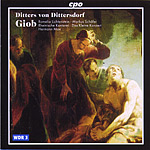After listening to this inspired oratorio, it’s clear why Carl Ditters von Dittersdorf was recognized in his day as Franz Joseph Haydn’s primary competitor. It’s a lovely work, loaded with drama, style, and expertly crafted instrumental and vocal writing. From the dramatic dotted rhythms and churning string sequences of the overture to the resounding spirited choral fugue finale, Dittersdorf’s music masterfully propels his grandiose subject matter, commanding attention more profoundly than any recorded vocal/choral work in recent memory (and this one’s more than two and a half hours long!). No wonder (according to the notes) Emperor Joseph II engaged Dittersdorf in lengthy complimentary conversation after a performance (as well as having a copy of the score made for his own use, somewhat to the composer’s consternation).
Dittersdorf’s brilliance notwithstanding, much of the credit for bringing Job to life goes to the performers, many of whom are seasoned veterans. Conductor Hermann Max for instance, has a long-standing reputation for rescuing little-known 18th-century treasures, and he couldn’t be in finer form here. Listen for example to the way he negotiates the exhilarating scene where Job first witnesses God’s wrath. The turbulence of the music here rivals Gluck’s Dance of the Furies, and Max, aided by the ever-reliable Das Kleine Konzert and Rheinische Kantorei, seizes every opportunity to thrill.
The soloists also excel in delivering charged, immediate characterizations. Markus Schäfer’s Job is superb, his voice a seamless light tenor. His rendering of the arias “Pass a il giorno, e me ritrova” and “Sento novello giubilo” (with flute obbligato) are particularly striking. Soprano Romelia Lichtenstein is just as captivating in her role as Job’s wife, with fine coloratura on top. Her challenging aria “E follia d’un alma stolta” is absolutely stunning–as convincing a vocal tour de force as it is a formidable renunciation of Job’s beliefs.
CPO’s engineering team rises to the occasion as well, capturing all the action with richly detailed sonics set in a believably balanced acoustic space. The accompanying booklet features extensive informative and entertaining notes by Ulrich Leisinger as well as full texts and translations. All in all, a grand undertaking! Miss this one at your peril!
































